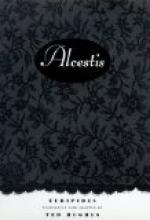The rule was that after three tragedies proper there came a play, still in tragic diction, with a traditional saga plot and heroic characters, in which the Chorus was formed by these Satyrs. There was a deliberate clash, an effect of burlesque; but of course the clash must not be too brutal. Certain characters of the heroic saga are, so to speak, at home with Satyrs and others are not. To take our extant specimens of Satyr-plays, for instance: in the Cyclops we have Odysseus, the heroic trickster; in the fragmentary Ichneutae of Sophocles we have the Nymph Cyllene, hiding the baby Hermes from the chorus by the most barefaced and pleasant lying; later no doubt there was an entrance of the infant thief himself. Autolycus, Sisyphus, Thersites are all Satyr-play heroes and congenial to the Satyr atmosphere; but the most congenial of all, the one hero who existed always in an atmosphere of Satyrs and the Komos until Euripides made him the central figure of a tragedy, was Heracles. [Footnote: The character of Heracles in connexion with the Komos, already indicated by Wilamowitz and Dieterich (Herakles, pp. 98, ff.; Pulcinella, pp. 63, ff.), has been illuminatingly developed in an unpublished monograph by Mr. J.A.K. Thomson, of Aberdeen.]
The complete Satyr-play had a hero of this type and a Chorus of Satyrs. But the complete type was refined away during the fifth century; and one stage in the process produced a play with a normal chorus but with one figure of the Satyric or “revelling” type. One might almost say the “comic” type if, for the moment, we may remember that that word is directly derived from ‘Komos.’
The Alcestis is a very clear instance of this Pro-satyric class of play. It has the regular tragic diction, marked here and there (393, 756, 780, etc.) by slight extravagances and forms of words which are sometimes epic and sometimes over-colloquial; it has a regular saga plot, which had already been treated by the old poet Phrynichus in his Alcestis, a play which is now lost but seems to have been Satyric; and it has one character straight from the Satyr world, the heroic reveller, Heracles. It is all in keeping that he should arrive tired, should feast and drink and sing; should be suddenly sobered and should go forth to battle with Death. It is also in keeping that the contest should have a half-grotesque and half-ghastly touch, the grapple amid the graves and the cracking ribs.
* * * * *
So much for the traditional form. As for the subject, Euripides received it from Phrynichus, and doubtless from other sources. We cannot be sure of the exact form of the story in Phrynichus. But apparently it told how Admetus, King of Pherae in Thessaly, received from Apollo a special privilege which the God had obtained, in true Satyric style, by making the Three Fates drunk and cajoling them. This was that, when his appointed time for death came,




